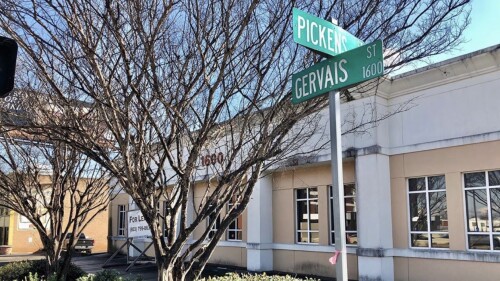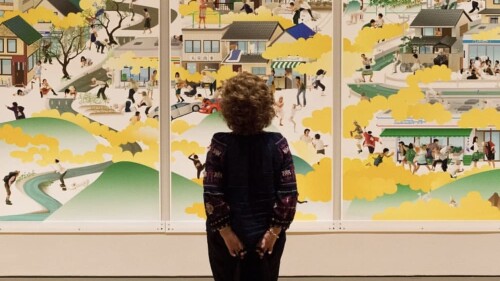This is part of our #TBT series in collaboration with Historic Columbia.
We’re back with Modern Love Pt. II, and this time, the #TBT is coming from inside the house.
That’s right. The weather is colder, there’s a fire in the hearth, and we’re staying indoors for this deep dive. Inspired by the gorgeous interiors on this year’s Palladium Fall Tour, this week is dedicated to exploring Mid-Century Modern furniture design.
So grab a seat in the conversation pit and let’s get started.
A quick refresher:
When we talk about “Mid-Century Modern” (MCM) we’re using it as a catchall term for architecture, furniture, and graphic design from the middle of the 20th century.
To recap, MCM architecture is diverse and can feature any of the following: asymmetrical facades, elevation on stilts, walls of windows with sliding glass doors, sky lights, portrait or ribbon windows, attached garages, or—if you’re a cool kid—an in-ground pool.
Mid-Century Modern furniture compliments all those details in the design grab bag above. It’s characterized by clean lines, organic shapes, streamlined forms, and a lack of embellishments. Mid-Century Modern furniture is equal parts sculpture and utility.
Like we went over last time, scientific advances, mass-production, and a booming middle class converged in the post-war economy to produce an atmosphere hungry for affordable, high-quality domestic design.
As early as 1938, the Museum of Modern Art in New York began compiling lists of quality, low-cost furniture. Their Good Design program partnered with department stores and supermarkets to connect affordable, well-designed products with the average American. At least two Columbia supermarkets (including the old Five Points Piggly Wiggly) participated in Good Design or a similar program. Folks were eager to fill their homes with Modern, fashionable designs.
But what did those designs look like?
One word: Plastics
Big names in 20th-century design like Charles and Ray Eames and Eero Saarinen earned notoriety by transforming familiar materials into new shapes. Designers sculpted concrete, folded wood into waves, and formed multi-colored plastics into countless pieces of furniture. Why? Because these materials were cheap and available in mass quantities.
Charles and Ray Eames designed the Eames Plastic Chair in 1950 for the International Competition for Low-cost Furniture Design held by the MOMA. (Told you they were really into affordable art.)
The chair was an overnight sensation. It was durable, easy to clean, comfortable, lightweight, and adaptable to any space. It fit in just as well in a formal dining room as it did on the beach. Check out this shot of an Eames on the sand:
And the Eero Saarinen Tulip chair + table duo is so ubiquitous that it can go unnoticed in everyday design. Here’s Saarinen’s original patent from 1958:

Image via Google Patents.
But where did Soda Citizens of the 1950s and ‘60s go when they wanted an Eames or a Saarinen of their own? To chat with Herman Miller, of course.
Mid-South, Mid-Century
The question is not who is Herman Miller, but what is Herman Miller. Founded in Michigan, Herman Miller was—and still is!—a distributor of classic design. They worked with legendary creators including Charles and Ray Eames, Eero Saarinen, Francis Knoll, and tons of other groundbreaking designers from around the world.
So what? Well, Herman Miller is also responsible for bringing high-quality designs to American consumers at low prices. In a time before Swedish Walmart (a.k.a. Ikea), Herman Miller showrooms offered a chance for customers to design a model of their dream room before making any purchases.
In Columbia in the ‘50s and ‘60s, Soda Citizens thirsty for good design could find it in a handful of Herman Miller showrooms across the city. Most notable was Mid-South Industries. Located at 6000 North Main (just up the street from today’s Obama gas station), Mid-South Industries sold the latest and greatest in MCM domestic design.
Opened in 1959, Mid-South Industries served as both a manufacturer and a retailer. Among the many products designed by Mid-South were skylights for “home, school, and work.” They employed an entire division of design associates who helped Columbia citizens sketch their perfect family rooms.
Where does that leave us?
Mid-South sold direct to consumers, but it also sold to local architecture firms like Maynard Pearlstine, LaFaye, Fair & LaFaye, and LBC&W—all three of whom designed stops featured on this year’s Palladium Fall Tour.
If you’d like a closer look at the types of furniture Mid-South had to offer (and spend time in a few totally Instagrammable houses) then join us on Sunday, Nov. 3 as we go behind the scenes in some of the best Mid-Century Modern designs Columbia has to offer.
This signature shindig takes you through magnificent Mid-Century homes, one iconic office building, and ends with an aviation-themed afterparty at the Hunter Gatherer Hangar. Your first beer is on us with when you show your Fall Tour wristband. Cheers to that!
Advance tickets are $25 for Palladium members, $30 for Historic Columbia members, and $40 for the general public. Advance ticket sales end Friday, Nov. 1. Any remaining tickets will be available day of at the Historic Columbia Gift Shop for $40, so don’t wait!
This time, we’re leaving you with a song all about Mid-Century Modern on film. This one goes out to all you Uma Thurman devotees out there.
That’s it for us this week. If you need me, I’ll be making sure the Hangar is afterparty ready.
-Lois, temporarily on loan to Historic Columbia
















